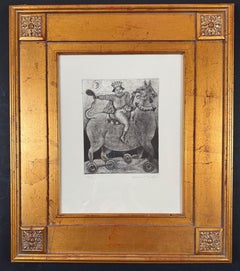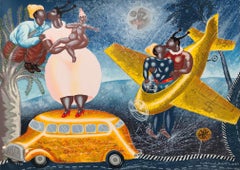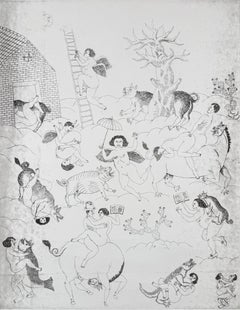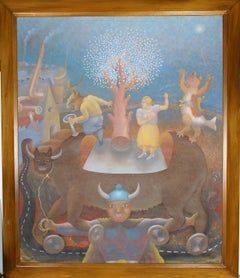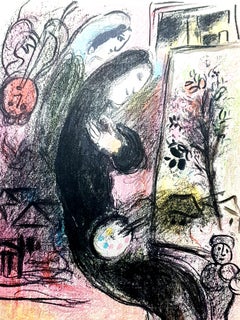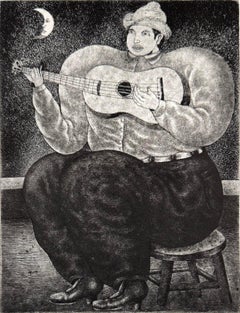Maximino Javier Art
Mexican, b. 1948
Maximino Javier (b. 1948) is a renowned Oaxacan artist recognized for his exploration of Latin American mythology in his art. He was a founding member of the Rufino Tamayo Workshop in Oaxaca, where he developed a distinct artistic approach emphasizing technical precision and cultural storytelling. His work often blends popular traditions with mythical narratives, employing meticulous use of color, form, and composition to transform folkloric themes into complex artistic statements.
Javier's art is known for its fantasy-oriented and whimsical nature, often featuring anthropomorphic elements and imaginative compositions, as seen in the expressive moon and stylized figures. His works frequently explore themes from Latin American mythology and the intricate relationship between humans and nature, reflected in the depiction of the musician and the moon in a mystical setting.
Unmistakable Iconography: Javier developed a unique and recognizable iconography, which is evident in the distinct forms and imaginative portrayal of characters and elements in these pieces, matching his unique aesthetic.to
1
2
1
1
Overall Width
to
Overall Height
to
3
1
1
2
2
1
3
1
4
3
3
1
1
1
1
1
1
1
2
2
1
1
1
4
9,478
2,688
1,375
1,361
2
4
Artist: Maximino Javier
untitled (horseman)
By Maximino Javier
Located in Palm Springs, CA
This whimsical and surreal etching by Mexican artist Maximino Javier, dated 1984, embodies his unique visual language that blends fantasy, folklore, and satire. Executed with intrica...
Category
1980s Contemporary Maximino Javier Art
Materials
Etching
Maximino Javier Mexican artist original hand signed silkscreen surrealism
By Maximino Javier
Located in Miami, FL
Maximino Javier (Mexico, 1948)
'Bajada de emergencia (serie Tamayo Total)', 2023
silkscreen on paper Canson 320 g.
20.3 x 28.2 in. (51.5 x 71.5 cm.)
Edition of 100
Unframed
ID: JAV-1...
Category
2010s Surrealist Maximino Javier Art
Materials
Cotton, Paper, Screen
El Jardin de las Delicias, by Maximino Javier
By Maximino Javier
Located in Palm Springs, CA
El Jardín de las Delicias by Maximino Javier was created in 1970. This date places it within a significant period of artistic exploration, reflecting the cultural and social themes p...
Category
1970s Surrealist Maximino Javier Art
Materials
Etching
$300 Sale Price
57% Off
Bull on Wheels (Dancing)
By Maximino Javier
Located in Long Island City, NY
An Oaxacan School oil painting by Maximino Javier from 1983. A whimsical scene of anthropomorphic figures. Framed in stained wood frame, signed in lower left corner.
Artist: Maximino Javier, Mexican (1948 - )
Title: Untitled - Bull on Wheels...
Category
1980s Folk Art Maximino Javier Art
Materials
Canvas, Oil
Price Upon Request
Related Items
"Simchat Torah in the Synagogue, " Leo Schutzman, Jewish Folk Art
By Leo Schutzman
Located in New York, NY
Leo Schutzman (1878 - 1962)
Simchat Torah in the Synagogue, circa 1958
Oil on canvas
40 x 36 inches
Signed lower left
Provenance:
The Contemporaries Gal...
Category
1950s Folk Art Maximino Javier Art
Materials
Canvas, Oil
Marc Chagall - Inspiration - Original Lithograph from "Chagall Lithographe" v. 2
By Marc Chagall
Located in Collonge Bellerive, Geneve, CH
Marc Chagall
Original Lithograph from Chagall Lithographe 1957-1962. VOLUME II.
1963
Dimensions: 32 x 24 cm
From the unsigned edition of 10000 copies without margins
Reference: Mourlot 398
Condition : Excellent
Marc Chagall (born in 1887)
Marc Chagall was born in Belarus in 1887 and developed an early interest in art. After studying painting, in 1907 he left Russia for Paris, where he lived in an artist colony on the city’s outskirts. Fusing his own personal, dreamlike imagery with hints of the fauvism and cubism popular in France at the time, Chagall created his most lasting work—including I and the Village (1911)—some of which would be featured in the Salon des Indépendants exhibitions. After returning to Vitebsk for a visit in 1914, the outbreak of WWI trapped Chagall in Russia. He returned to France in 1923 but was forced to flee the country and Nazi persecution during WWII. Finding asylum in the U.S., Chagall became involved in set and costume design before returning to France in 1948. In his later years, he experimented with new art forms and was commissioned to produce numerous large-scale works. Chagall died in St.-Paul-de-Vence in 1985.
The Village
Marc Chagall was born in a small Hassidic community on the outskirts of Vitebsk, Belarus, on July 7, 1887. His father was a fishmonger, and his mother ran a small sundries shop in the village. As a child, Chagall attended the Jewish elementary school, where he studied Hebrew and the Bible, before later attending the Russian public school. He began to learn the fundamentals of drawing during this time, but perhaps more importantly, he absorbed the world around him, storing away the imagery and themes that would feature largely in most of his later work.
At age 19 Chagall enrolled at a private, all-Jewish art school and began his formal education in painting, studying briefly with portrait artist Yehuda Pen. However, he left the school after several months, moving to St. Petersburg in 1907 to study at the Imperial Society for the Protection of Fine Arts. The following year, he enrolled at the Svanseva School, studying with set designer Léon Bakst, whose work had been featured in Sergei Diaghilev's Ballets Russes. This early experience would prove important to Chagall’s later career as well.
Despite this formal instruction, and the widespread popularity of realism in Russia at the time, Chagall was already establishing his own personal style, which featured a more dreamlike unreality and the people, places and imagery that were close to his heart. Some examples from this period are his Window Vitebsk (1908) and My Fianceé with Black Gloves (1909), which pictured Bella Rosenfeld, to whom he had recently become engaged.
The Beehive
Despite his romance with Bella, in 1911 an allowance from Russian parliament member and art patron Maxim Binaver enabled Chagall to move to Paris, France. After settling briefly in the Montparnasse neighborhood, Chagall moved further afield to an artist colony known as La Ruche (“The Beehive”), where he began to work side by side with abstract painters such as Amedeo Modigliani and Fernand Léger as well as the avant-garde poet Guillaume Apollinaire. At their urging, and under the influence of the wildly popular fauvism and cubism, Chagall lightened his palette and pushed his style ever further from reality. I and the Village (1911) and Homage to Apollinaire (1912) are among his early Parisian works, widely considered to be his most successful and representative period.
Though his work stood stylistically apart from his cubist contemporaries, from 1912 to 1914 Chagall exhibited several paintings at the annual Salon des Indépendants exhibition, where works by the likes of Juan Gris, Marcel Duchamp and Robert Delaunay were causing a stir in the Paris art world. Chagall’s popularity began to spread beyond La Ruche, and in May 1914 he traveled to Berlin to help organize his first solo exhibition, at Der Sturm Gallery. Chagall remained in the city until the highly acclaimed show opened that June. He then returned to Vitebsk, unaware of the fateful events to come.
War, Peace and Revolution
In August 1914 the outbreak of World War I precluded Chagall’s plans to return to Paris. The conflict did little to stem the flow of his creative output, however, instead merely giving him direct access to the childhood scenes so essential to his work, as seen in paintings such as Jew in Green (1914) and Over Vitebsk (1914). His paintings from this period also occasionally featured images of the war’s impact on the region, as with Wounded Soldier (1914) and Marching (1915). But despite the hardships of life during wartime, this would also prove to be a joyful period for Chagall. In July 1915 he married Bella, and she gave birth to a daughter, Ida, the following year. Their appearance in works such as Birthday (1915), Bella and Ida by the Window (1917) and several of his “Lovers” paintings give a glimpse of the island of domestic bliss that was Chagall’s amidst the chaos.
To avoid military service and stay with his new family, Chagall took a position as a clerk in the Ministry of War Economy in St. Petersburg. While there he began work on his autobiography and also immersed himself in the local art scene, befriending novelist Boris Pasternak, among others. He also exhibited his work in the city and soon gained considerable recognition. That notoriety would prove important in the aftermath of the 1917 Russian Revolution when he was appointed as the Commissar of Fine Arts in Vitebsk. In his new post, Chagall undertook various projects in the region, including the 1919 founding of the Academy of the Arts. Despite these endeavors, differences among his colleagues eventually disillusioned Chagall. In 1920 he relinquished his position and moved his family to Moscow, the post-revolution capital of Russia.
In Moscow, Chagall was soon commissioned to create sets and costumes for various productions at the Moscow State Yiddish Theater...
Category
1960s Surrealist Maximino Javier Art
Materials
Lithograph
$1,477
H 9.45 in W 12.6 in D 0.04 in
Marc Chagall - The Candlestick - Original Lithograph
By Marc Chagall
Located in Collonge Bellerive, Geneve, CH
The Candlestick, from Jean Leymarie, Vitraux pour Jérusalem (Jerusalem Windows), André Sauret, Monte Carlo, 1962 (see M. 366-72; see C. books ...
Category
1960s Surrealist Maximino Javier Art
Materials
Lithograph
$2,482
H 12.8 in W 9.65 in D 0.04 in
Balance, Whimsical female with flowers, roses, bright golden sky
By Stephen Basso
Located in Brooklyn, NY
*ABOUT Stephen Basso
Stephen Basso's highly original pastels and oil paintings are romantic, yet thought provoking fantasies. His whimsical works are alive with boundless imagina...
Category
2010s Outsider Art Maximino Javier Art
Materials
Canvas, Oil
$3,200
H 40 in W 40 in D 2 in
Mississippi River Landscape
By Saul Haymond
Located in Lake Worth Beach, FL
Landscape Mississippi River.
Saul Haymond, Sr. (1947- ) of Pickens, Mississippi is a self-taught painter who has been documenting life in the African American community in Holmes Co...
Category
1960s Outsider Art Maximino Javier Art
Materials
Canvas, Oil
Salvador Dali - Corrida - Vintage Poster with Etching
By Salvador Dalí
Located in Collonge Bellerive, Geneve, CH
Salvador Dali - Corrida - Vintage Poster with Etching
Etching made behind a menu in Restautant Duran as a tribute dinner to Salvador Dali and his wife Ga...
Category
1960s Surrealist Maximino Javier Art
Materials
Etching
Untitled (Horses)
By Laura Owens
Located in New York, NY
Los Angeles-based artist, Laura Owens' horse prints often incorporate her characteristic style, which challenges traditional assumptions about figuration and abstraction . Her work f...
Category
Early 2000s Contemporary Maximino Javier Art
Materials
Etching, Aquatint
Roy De Forest, Dog lithograph, signed/n by world renowned California pet painter
By Roy De Forest
Located in New York, NY
Roy De Forest
Untitled (Dog), 1981
Color lithograph with deckled edges. Floated and framed.
Pencil signed and numbered from the edition of 125
Frame Included: held in original vintage white frame
Wonderful whimsical rare 1981 lithograph by the incredibly popular and beloved Roy de Forest, famous for his paintings and prints of dogs...
Category
1980s Surrealist Maximino Javier Art
Materials
Lithograph
$1,700
H 35.25 in W 26.75 in D 1 in
Bull - Still Life (Surreal, Colorful, Vibrant, Modern) (26% OFF LIST PRICE)
Located in Kansas City, MO
Franz Graw
Bull
Color Offset Lithograph
Year: 2023
Size: 11.81 x 15.74 inches (30 x 40 cm)
Edition: 100
Signed and numbered in pencil
COA provided
Franz Graw (b. 1964) is a Düsseld...
Category
2010s Surrealist Maximino Javier Art
Materials
Lithograph, Offset
$66 Sale Price
25% Off
H 16.53 in W 11.73 in
Reclining Female (Surreal, Colorful, Vibrant, Modern) (25% OFF LIST PRICE)
Located in Kansas City, MO
Franz Graw
Reclining Female (Surreal, Colorful, Vibrant, Modern)
Color Offset Lithograph
Year: 2021
Size: 16.53 x 11.73 inches (42 x 29.8 cm)
Edition: 100
Signed and numbered in penc...
Category
2010s Surrealist Maximino Javier Art
Materials
Lithograph, Offset
$67 Sale Price
24% Off
H 16.53 in W 11.73 in
“Boy with Blue Birds”
By Agapito Labios
Located in Southampton, NY
Original oil on canvas folk art painting by the well known Mexican artist, Agapito Labios. Signed lower right. Circa 1935. Condition is very good. ...
Category
1930s Folk Art Maximino Javier Art
Materials
Canvas, Oil
Marc Chagall - Original Lithograph
By Marc Chagall
Located in Collonge Bellerive, Geneve, CH
Marc Chagall
Original Lithograph
1963
Dimensions: 32 x 24 cm
Reference: Chagall Lithographe 1957-1962. VOLUME II.
Condition : Excellent
Marc Chagall (born in 1887)
Marc Chagall was born in Belarus in 1887 and developed an early interest in art. After studying painting, in 1907 he left Russia for Paris, where he lived in an artist colony on the city’s outskirts. Fusing his own personal, dreamlike imagery with hints of the fauvism and cubism popular in France at the time, Chagall created his most lasting work—including I and the Village (1911)—some of which would be featured in the Salon des Indépendants exhibitions. After returning to Vitebsk for a visit in 1914, the outbreak of WWI trapped Chagall in Russia. He returned to France in 1923 but was forced to flee the country and Nazi persecution during WWII. Finding asylum in the U.S., Chagall became involved in set and costume design before returning to France in 1948. In his later years, he experimented with new art forms and was commissioned to produce numerous large-scale works. Chagall died in St.-Paul-de-Vence in 1985.
The Village
Marc Chagall was born in a small Hassidic community on the outskirts of Vitebsk, Belarus, on July 7, 1887. His father was a fishmonger, and his mother ran a small sundries shop in the village. As a child, Chagall attended the Jewish elementary school, where he studied Hebrew and the Bible, before later attending the Russian public school. He began to learn the fundamentals of drawing during this time, but perhaps more importantly, he absorbed the world around him, storing away the imagery and themes that would feature largely in most of his later work.
At age 19 Chagall enrolled at a private, all-Jewish art school and began his formal education in painting, studying briefly with portrait artist Yehuda Pen. However, he left the school after several months, moving to St. Petersburg in 1907 to study at the Imperial Society for the Protection of Fine Arts. The following year, he enrolled at the Svanseva School, studying with set designer Léon Bakst, whose work had been featured in Sergei Diaghilev's Ballets Russes. This early experience would prove important to Chagall’s later career as well.
Despite this formal instruction, and the widespread popularity of realism in Russia at the time, Chagall was already establishing his own personal style, which featured a more dreamlike unreality and the people, places and imagery that were close to his heart. Some examples from this period are his Window Vitebsk (1908) and My Fianceé with Black Gloves (1909), which pictured Bella Rosenfeld, to whom he had recently become engaged.
The Beehive
Despite his romance with Bella, in 1911 an allowance from Russian parliament member and art patron Maxim Binaver enabled Chagall to move to Paris, France. After settling briefly in the Montparnasse neighborhood, Chagall moved further afield to an artist colony known as La Ruche (“The Beehive”), where he began to work side by side with abstract painters such as Amedeo Modigliani and Fernand Léger as well as the avant-garde poet Guillaume Apollinaire. At their urging, and under the influence of the wildly popular fauvism and cubism, Chagall lightened his palette and pushed his style ever further from reality. I and the Village (1911) and Homage to Apollinaire (1912) are among his early Parisian works, widely considered to be his most successful and representative period.
Though his work stood stylistically apart from his cubist contemporaries, from 1912 to 1914 Chagall exhibited several paintings at the annual Salon des Indépendants exhibition, where works by the likes of Juan Gris, Marcel Duchamp and Robert Delaunay were causing a stir in the Paris art world. Chagall’s popularity began to spread beyond La Ruche, and in May 1914 he traveled to Berlin to help organize his first solo exhibition, at Der Sturm Gallery. Chagall remained in the city until the highly acclaimed show opened that June. He then returned to Vitebsk, unaware of the fateful events to come.
War, Peace and Revolution
In August 1914 the outbreak of World War I precluded Chagall’s plans to return to Paris. The conflict did little to stem the flow of his creative output, however, instead merely giving him direct access to the childhood scenes so essential to his work, as seen in paintings such as Jew in Green (1914) and Over Vitebsk (1914). His paintings from this period also occasionally featured images of the war’s impact on the region, as with Wounded Soldier (1914) and Marching (1915). But despite the hardships of life during wartime, this would also prove to be a joyful period for Chagall. In July 1915 he married Bella, and she gave birth to a daughter, Ida, the following year. Their appearance in works such as Birthday (1915), Bella and Ida by the Window (1917) and several of his “Lovers” paintings give a glimpse of the island of domestic bliss that was Chagall’s amidst the chaos.
To avoid military service and stay with his new family, Chagall took a position as a clerk in the Ministry of War Economy in St. Petersburg. While there he began work on his autobiography and also immersed himself in the local art scene, befriending novelist Boris Pasternak, among others. He also exhibited his work in the city and soon gained considerable recognition. That notoriety would prove important in the aftermath of the 1917 Russian Revolution when he was appointed as the Commissar of Fine Arts in Vitebsk. In his new post, Chagall undertook various projects in the region, including the 1919 founding of the Academy of the Arts. Despite these endeavors, differences among his colleagues eventually disillusioned Chagall. In 1920 he relinquished his position and moved his family to Moscow, the post-revolution capital of Russia.
In Moscow, Chagall was soon commissioned to create sets and costumes for various productions at the Moscow State Yiddish Theater...
Category
1960s Surrealist Maximino Javier Art
Materials
Lithograph
Previously Available Items
The Guitar Player
By Maximino Javier
Located in Palm Springs, CA
This whimsical and surreal etching by Mexican artist Maximino Javier, dated 1984, embodies his unique visual language that blends fantasy, folklore, and satire.
Medium: Lithograph
...
Category
1980s Contemporary Maximino Javier Art
Materials
Etching
Maximino Javier art for sale on 1stDibs.
Find a wide variety of authentic Maximino Javier art available for sale on 1stDibs. If you’re browsing the collection of art to introduce a pop of color in a neutral corner of your living room or bedroom, you can find work that includes elements of blue and other colors. You can also browse by medium to find art by Maximino Javier in canvas, fabric, oil paint and more. Not every interior allows for large Maximino Javier art, so small editions measuring 40 inches across are available. Customers who are interested in this artist might also find the work of Jose Maria de Servin, Branko Bahunek, and Jaimendes. Maximino Javier art prices can differ depending upon medium, time period and other attributes. On 1stDibs, the price for these items starts at $125,000 and tops out at $125,000, while the average work can sell for $125,000.
